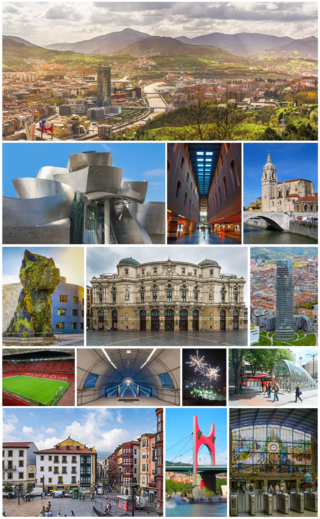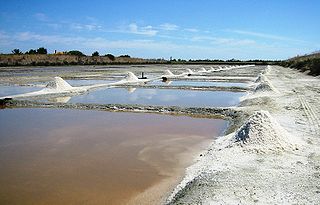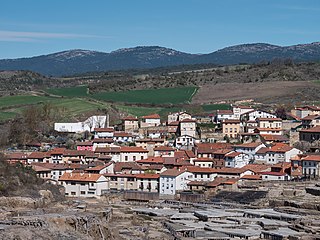
Bilbao is a city in northern Spain, the largest city in the province of Biscay and in the Basque Country as a whole. It is also the largest city proper in northern Spain. Bilbao is the tenth largest city in Spain, with a population of more than 347,000 as of 2023. The Bilbao metropolitan area has 1,037,847 inhabitants, making it the most populous metropolitan area in northern Spain; with a population of 875,552 comarca of Greater Bilbao is the fifth-largest urban area in Spain. Bilbao is also the main urban area in what is defined as the Greater Basque region.

Vitoria-Gasteiz, also alternatively spelled as Vittoria in older English-language sources, is the seat of government and the capital city of the Basque Country and of the province of Álava in northern Spain. It holds the autonomous community's House of Parliament, the headquarters of the Government, and the Lehendakari's official residency. The municipality—which comprises not only the city but also the mainly agricultural lands of 63 villages around—is the largest in the Basque Country, with a total area of 276.81 square kilometres (106.88 sq mi), and it has a population of 253,093. The dwellers of Vitoria-Gasteiz are called vitorianos or gasteiztarrak, while traditionally they are dubbed babazorros.

Jujuy[xuˈxuj] is a province of Argentina, located in the extreme northwest of the country, at the borders with Chile and Bolivia. The only neighboring Argentine province is Salta to the east and south.

La Pampa is a sparsely populated province of Argentina, located in the Pampas in the center of the country. Neighboring provinces are from the north clockwise San Luis, Córdoba, Buenos Aires, Río Negro, Neuquén and Mendoza.

The Salinas Valley is one of the major valleys and most productive agricultural regions in California. It is located west of the San Joaquin Valley and south of San Francisco Bay and the Santa Clara Valley.

A salt evaporation pond is a shallow artificial salt pan designed to extract salts from sea water or other brines. The salt pans are shallow and expansive, allowing sunlight to penetrate and reach the seawater. Natural salt pans are formed through geological processes, where water evaporating, leaving behind salts deposits. Some salt evaporation ponds are only slightly modified from their natural version, such as the ponds on Great Inagua in the Bahamas, or the ponds in Jasiira, a few kilometres south of Mogadishu, where seawater is trapped and left to evaporate in the sun.

Santa Pola is a coastal town located in the comarca of Baix Vinalopó in the Valencian Community, Spain, by the Mediterranean Sea. It has an area of 58.6 km2 (23 sq mi) and has a population of 36,174 inhabitants of whom 6,000 are residents of the nearby town of Gran Alacant.

Salt, also referred to as table salt or by its chemical formula NaCl, is an ionic compound made of sodium and chloride ions. All life depends on its chemical properties to survive. It has been used by humans for thousands of years, from food preservation to seasoning. Salt's ability to preserve food was a founding contributor to the development of civilization. It helped eliminate dependence on seasonal availability of food, and made it possible to transport food over large distances. However, salt was often difficult to obtain, so it was a highly valued trade item, and was considered a form of currency by certain people. Many salt roads, such as the Via Salaria in Italy, had been established by the Bronze Age.

Fuencaliente de La Palma, also Fuencaliente, is a municipality in the southern part of the island La Palma in the province of Santa Cruz de Tenerife of the Canary Islands, Spain. The seat of the municipality is the village Los Canarios. It has been the seat since 1837. The population of the municipality is 1,798 (2013) and the area is 56.42 km².

Leintz Gatzaga is a town located in the province of Gipuzkoa, in the Autonomous Community of Basque Country, northern Spain. The municipality's population is 251 (2015).

Añana is both a valley and municipality located in the province of Álava, in the Basque Country, northern Spain. Its main population center is the village of Salinas de Añana. Moreover, Añana is also the name of one of the seven counties in which the province of Álava is divided. The town is renowned for its old salt flats, which were formed beginning in the Triassic Period.

Pedra de Lume is a village in the northeastern part of the island of Sal, Cape Verde. The village is situated on the east coast, about 5 km east of the island capital Espargos. It has a small port and a lighthouse, Farol de Pedra de Lume.

Salar de Atacama, located 55 km (34 mi) south of San Pedro de Atacama, is the largest salt flat in Chile. It is surrounded by mountains and lacks drainage outlets. To the east, it is enclosed by the main chain of the Andes, while to the west lies a secondary mountain range called Cordillera de Domeyko. The landscape is dominated by imposing volcanoes such as Licancabur, Acamarachi, Aguas Calientes, and Láscar, the latter being one of Chile's most active volcanoes. These volcanoes are situated along the eastern side of the Salar de Atacama, forming a north–south trending line that separates it from smaller endorheic basins.

Poza de la Sal is a municipality and town located in the province of Burgos, Castile and León, Spain. According to the 2004 census (INE), the municipality has a population of 387 inhabitants.

Valle de Villaverde is a town and municipality in the autonomous community of Cantabria, Spain. It is surrounded by the Basque municipalities of Carranza, Arcentales, and Trucíos, but the town belongs to the administration of the government of Cantabria. Thus, it is an enclave of Biscay and an exclave of Cantabria.

Lake Arreo, also known as the Caicedo-Yuso Lake is a lake in the province of Álava, Basque Country, Spain. With a surface of 6.5 ha, it is the only natural lake in the Basque Country.

The Península Valdés Railway was an Argentine narrow gauge railway that joined the city of Puerto Pirámides with the salt evaporation pond known as Salinas Grandes, both in Chubut Province. The railway operated passenger and freight services, with two intermediate stops.
Lorena López de Lacalle Arizti is a Basque politician, president of the European Free Alliance since 2019.

Exportadora de Sal S.A. is a company dedicated to salt production through solar evaporation of sea water in the Ojo de Liebre Lagoon, Baja California Sur, Mexico. Founded in 1954 by American shipping businessman Daniel K. Ludwig, it is currently partially owned by the Mexican government and Mitsubishi. It is one of the largest sea-salt extraction and processing operations in the world.

The Añana Diapir is a diapir in Álava, Basque Country, Spain. Two notable wetlands are located within the diapir: the Salt Valley of Añana and Lake Arreo. It was declared a protected biotope by the Basque Government in 2016.



















